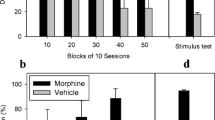Abstract
Male Sprague-Dawley rats were trained in a two lever food-reinforced procedure to discriminate between the effects of saline and the synthetic narcotic analgestic fentanyl (0.04 mg/kg). After acquisition of this discrimination, generalization tests with morphine, ethanol and some tetrahydroisoquinoline alkaloids were conducted. The rats dose-dependently generalized the effect of morphine but did not generalize the effects of either ethanol, tetrahydropapaveroline, salsolinol or 3-carboxysalsolinol to the fentanyl discriminative stimulus. Thus, these data do not support a biochemical link between ethanol and opiates.
Similar content being viewed by others
References
Altschuler HL, Applebaum E, Shippenberg TS (1981) The effects of opiate antagonists on the discriminative stimulus properties of ethanol. Pharmacol Biochem Behav 14:97–100
Altschuler HL, Shippenberg TS (1982) Tetrahydroisoquinoline and opioid substrates of alcohol actions. Prog Clin Biol Res 90:329–344
Berger T, French ED, Siggins GR, Shier WT, Bloom FE (1982) Ethanol and some tetrahydroisoquinolines alter the discharge of cortical and hippocampal neurons: Relationship to endogenous opioids. Pharmacol Biochem Behav 17:813–821
Catley DM, Jordan C, Frith CD, Lehane JR, Rhodes AM, Jones JG (1981) Alcohol induced discoordination is not reversed by naloxone. Psychopharmacology 75:65–68
Chipkin RE, Melchior CL, Deitrich RA (1979) Interaction of carboxysalsolinol with the ethanol discriminative stimulus. Commun Psychopharmacol 3:159–164
Cohen G, Collins M (1970) Alkaloids from catecholamines in adrenal tissue: Possible role in alcoholism. Science 167:1749–1751
Collins MA, Bigdelli MG (1975) Tetrahydroisoquinolines in vivo. I. Rat brain formation of salsolinol, a condensation product of dopamine and acetyldehyde, under certain conditions during ethanol intoxication. Life Sci 16:585–601
Colpaert FC (1978) Discriminative stimulus properties of narcotic analgesic drugs. Pharmacol Biochem Behav 9:863–887
Costall B, Naylor RJ, Pinder RM (1976) Hyperactivity induced by tetrahydroisoquinoline derivatives injected into nucleus accumbens. Eur J Pharmacol 39:153–160
Davis VE, Walsh MJ (1970) Alcohol, amines and alkaloids: A possible biochemical basis for alcohol addiction. Science 167:1005–1007
Fertel RH, Greenwald JE, Schwarz R, Wong L, Bianchine J (1980) Opiate receptor binding and analgesic effects of the tetrahydroisoquinolines salsolinol and tetrahydropapaveroline. Res Commun Chem Path Pharmacol 27:3–14
Goldstein A, Judson BA (1971) Alcohol dependence and opiate dependence: Lack of a relationship in mice. Science 172:290–292
Hamilton MG, Hirst M (1980) Alcohol-related tetraisoquinolines: Pharmacology and identification: Pharmacology and identification. Sub Alc Actions/Misuse 1:121–144
Hymson DL, Hynes MD (1982) Evidence that ethanol-induced impairment of roto-rod performance is not mediated by opioid mechanisms. Prog Neuropsychopharmacol Biol Psychiatr 6:159–165
Laschka E, Teschemacher H, Mehraein P, Herz A (1976) Sites of action of morphine involved in the development of physical dependence in rats. Psychopharmacologia 46:141–147
Marshall A, Hirst M, Blum K (1977) Analgesic effects of 3-carboxysalsolinol alone and in combination with morphine. Experientia 33:754–755
Melchior C, Collins MA (1982) The route and significance of endogenous synthesis of alkaloids in animals. CRC Crit Rev Toxicol 9:313–356
Miksic S, Shearman G, Lal H (1978) Generalization study with some narcotic and non-narcotic drugs in rats trained for morphine-saline discrimination. Psychopharmacology 60:103–104
Myers RD, Critcher EC (1982) Naloxone alters alcohol drinking induced in the rat by tetrahydropapaveroline (THP) infused ICV. Pharmacol Biochem Behav 16:827–836
Schecter MD (1980) Ability of 3-carboxysalsolinol to produce ethanol-like discrimination in rats. Psychopharmacology 68:277–281
Shearman GT, Herz A (1982) Evidence that the discriminative stimulus properties of fentanyl and ethylketocyclazocine are mediated by an interaction with different opiate receptors. J Pharmacol Exp Ther 221:735–739
Tampier L, Alpers HS, Davis VE (1977) Influence of catecholamine derived alkaloids and β-adrenergic blocking agents on stereospecific binding of 3H-naloxone. Res Commun Chem Pathol Pharmacol 17:731–734
Winter JC (1975) The stimulus properties of morphine and ethanol. Psychopharmacologia 44:209–214
Yamanaka Y, Walsh MJ, Davis VE (1970) Salsolinol: an alkaloid derivative of dopamine formed in vitro during alcohol metabolism. Nature 227:1143–1144
Author information
Authors and Affiliations
Rights and permissions
About this article
Cite this article
Shearman, G.T., Herz, A. Ethanol and tetrahydroisoquinoline alkaloids do not produce narcotic discriminative stimulus effects. Psychopharmacology 81, 224–227 (1983). https://doi.org/10.1007/BF00427266
Received:
Accepted:
Issue Date:
DOI: https://doi.org/10.1007/BF00427266




